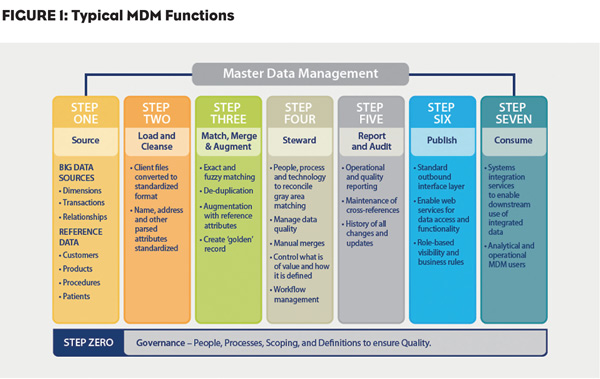Many life sciences companies find themselves in an unfortunate situation when it comes to their systems for managing their universal data, which is the information about customers and products that’s used by multiple functions in the organization. Given the cost and complexity of developing an enterprise-wide solution, they’ve allowed spot solutions to proliferate function by function, only to have integration issues later on.
However, companies need not be forced to choose between an expensive and powerful enterprise tool that they don’t yet need and functional solutions that won’t scale later on. With proper forethought and careful planning, they can ensure that their Universal Data Management (UDM) solutions solve their immediate needs and build toward what they’ll need in the future.
Setting a UDM strategy for a life sciences company is one of those responsibilities that largely goes unnoticed by downstream information consumers—that is, unless it was shortsighted or overly ambitious. Adopting an enterprise-wide solution that isn’t agile enough may leave some users frustrated as they stand in line for their unique needs to be addressed. Yet allowing functions to choose their own solutions could lead to incompatible systems that are at odds with the very purpose of UDM: Having a single version of the truth for a customer, a product or any of the UDM domain records.
Life sciences companies need to think strategically, prepare for the long term and act tactically to satisfy local and immediate needs when developing their UDM systems. The key is to understand where your company is headed and create a “road map” that will guide you along the way, ensuring that any tools can be integrated later on. Decisions made today will not need to be countermanded tomorrow if they’re made with all of the right future considerations.
What is Universal Data Management?
Universal Data Management (UDM) is a framework that addresses:
Flexible Infrastructure. Like any large enterprise, life sciences companies must solve the complex problem of breaking down silos between data assets, systems and business applications. Current solutions don’t address this problem well, hence the growing acceptance of Service Oriented Architecture-based infrastructure and cloud services.
However, pure adoption of these new technologies does not lead to nirvana, as dissimilar technology solutions acquired piecemeal are by their definition, disparate. They require effort and investment to integrate into an existing organization’s ecosystem. Even post-integration upgrade and roadmap concerns remain as disparate solutions will evolve based on their individual course, potentially out of synch with the overall ecosystem. The end result must be integration of data—regardless of the source of that data—across a strategically and technically unified ecosystem. UDM embraces the idea of solutions that interoperate and integrate and break down the barriers between silos of data and applications.
Dynamic Access. Life sciences companies spend billions of dollars acquiring data that are often delivered and managed in archaic systems that prevent quick time to market and ultimately increase cost and reduce productivity for the organization. With UDM, data is available on-demand with the ability to access, manage and provision data as defined by the business—not the structure of the network or delivery method of the data—and gives the data stewards and analysts control over their business.
Data Integrity. The ability to arrive at a “single version of the truth” is the goal of every organization and the source of major investment for life science organizations. This is most often achieved through a Master Data Management (MDM) solution (Figure 1) that is customized for the organization’s environment and business case. While there are very robust solutions available in the market, without a flexible infrastructure and dynamic access to all data sources, MDM becomes limited in its ability to deliver the coveted “golden record.”
In the UDM framework, master data becomes the “pivot” on which the business turns; once quality data is acquired, warehoused, managed and then mastered, it can be efficiently provisioned with confidence that the business is operating in a unified way.
Seamless Data Integration. If there is a description of nirvana in the data management world, this is it. Once quality data has been identified, acquired, warehoused, managed, accessed and mastered, it must be “served up” or accessed by the applications used by business professionals making critical decisions. And it has to happen automatically—independent of sources and vendors.
In the UDM framework, mastered data as well as volumetric data are seamlessly provisioned to business applications, automatically updated and always available for consumption. This is where insight happens and where ROI is maximized for the organization.
All life sciences companies should assume that, no matter where they currently are in their MDM development, they will eventually want and need a common UDM solution across their commercial organization. Whether it is for global financial analyses, for varying departments that need a comprehensive view of the customer, or for operational efficiencies, most organizations will at some point want to move beyond functional UDM solutions. By managing data in a UDM framework, life sciences companies can effectively manage these complexities as they exist today and be ready for the change that will undoubtedly come in the future. Sales reps will receive cleansed, timely, actionable insights that will empower them to succeed in their daily roles.





